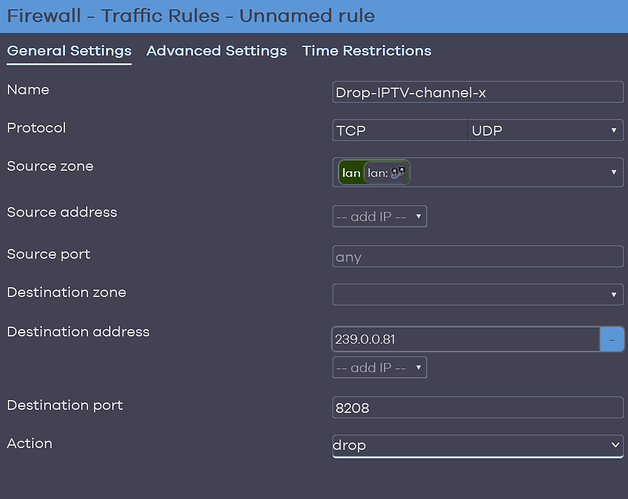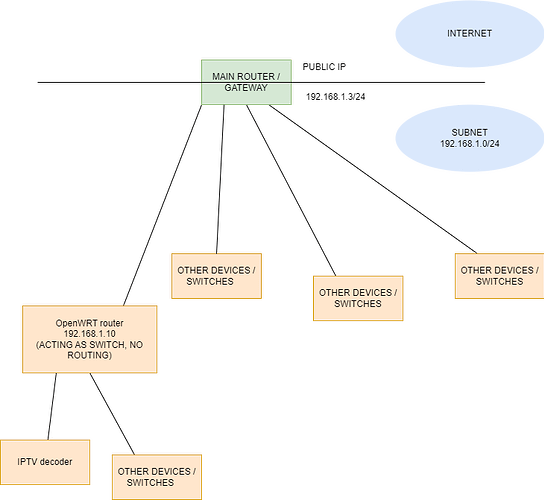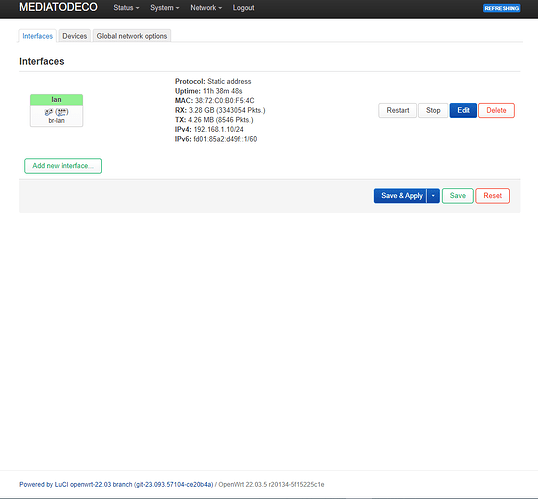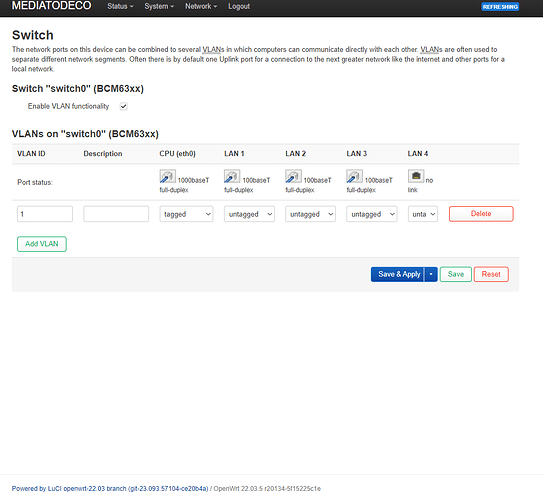Hi everyone,
I have a project in mind, involving an OpenWRT router, an Ubuntu server, and a IPTV decoder.
In this point of the development of the project, I'm having issues with nftables.
I installed nftables in my Comtrend AR-5387un router, with OpenWRT 22.03.
I configured table + chain + rule, in order to drop a stream of packets, all of them having the following unique characteristics (corresponding to an IPTV channel):
destination IP address (multicast): 239.0.0.81
destination UDP port: 8208
The nft commands I did:
nft add table bridge kodi
nft add chain bridge kodi channeldrop { type filter hook forward priority filter \; }
nft add rule bridge kodi channeldrop ether type ip ip daddr 239.0.0.81 ip protocol udp udp dport 8208 drop
and the output of the command nft list ruleset :
table inet fw4 {
chain input {
type filter hook input priority filter; policy accept;
iifname "lo" accept comment "!fw4: Accept traffic from loopback"
ct state established,related accept comment "!fw4: Allow inbound established and related flows"
tcp flags syn / fin,syn,rst,ack jump syn_flood comment "!fw4: Rate limit TCP syn packets"
iifname "br-lan" jump input_lan comment "!fw4: Handle lan IPv4/IPv6 input traffic"
}
chain forward {
type filter hook forward priority filter; policy drop;
ct state established,related accept comment "!fw4: Allow forwarded established and related flows"
iifname "br-lan" jump forward_lan comment "!fw4: Handle lan IPv4/IPv6 forward traffic"
jump handle_reject
}
chain output {
type filter hook output priority filter; policy accept;
oifname "lo" accept comment "!fw4: Accept traffic towards loopback"
ct state established,related accept comment "!fw4: Allow outbound established and related flows"
oifname "br-lan" jump output_lan comment "!fw4: Handle lan IPv4/IPv6 output traffic"
}
chain prerouting {
type filter hook prerouting priority filter; policy accept;
iifname "br-lan" jump helper_lan comment "!fw4: Handle lan IPv4/IPv6 helper assignment"
}
chain handle_reject {
meta l4proto tcp reject with tcp reset comment "!fw4: Reject TCP traffic"
reject comment "!fw4: Reject any other traffic"
}
chain syn_flood {
limit rate 25/second burst 50 packets return comment "!fw4: Accept SYN packets below rate-limit"
drop comment "!fw4: Drop excess packets"
}
chain input_lan {
jump accept_from_lan
}
chain output_lan {
jump accept_to_lan
}
chain forward_lan {
jump accept_to_wan comment "!fw4: Accept lan to wan forwarding"
jump accept_to_lan
}
chain helper_lan {
}
chain accept_from_lan {
iifname "br-lan" counter packets 124 bytes 8655 accept comment "!fw4: accept lan IPv4/IPv6 traffic"
}
chain accept_to_lan {
oifname "br-lan" counter packets 73 bytes 7528 accept comment "!fw4: accept lan IPv4/IPv6 traffic"
}
chain input_wan {
meta nfproto ipv4 udp dport 68 counter packets 0 bytes 0 accept comment "!fw4: Allow-DHCP-Renew"
icmp type echo-request counter packets 0 bytes 0 accept comment "!fw4: Allow-Ping"
meta nfproto ipv4 meta l4proto igmp counter packets 0 bytes 0 accept comment "!fw4: Allow-IGMP"
meta nfproto ipv6 udp dport 546 counter packets 0 bytes 0 accept comment "!fw4: Allow-DHCPv6"
ip6 saddr fe80::/10 icmpv6 type . icmpv6 code { mld-listener-query . no-route, mld-listener-report . no-route, mld-listener-done . no-route, mld2-listener-report . no-route } counter packets 0 bytes 0 accept comment "!fw4: Allow-MLD"
icmpv6 type { destination-unreachable, time-exceeded, echo-request, echo-reply, nd-router-solicit, nd-router-advert } limit rate 1000/second counter packets 0 bytes 0 accept comment "!fw4: Allow-ICMPv6-Input"
icmpv6 type . icmpv6 code { packet-too-big . no-route, parameter-problem . no-route, parameter-problem . admin-prohibited, nd-neighbor-solicit . no-route, nd-neighbor-advert . no-route } limit rate 1000/second counter packets 0 bytes 0 accept comment "!fw4: Allow-ICMPv6-Input"
jump reject_from_wan
}
chain output_wan {
jump accept_to_wan
}
chain forward_wan {
icmpv6 type { destination-unreachable, time-exceeded, echo-request, echo-reply } limit rate 1000/second counter packets 0 bytes 0 accept comment "!fw4: Allow-ICMPv6-Forward"
icmpv6 type . icmpv6 code { packet-too-big . no-route, parameter-problem . no-route, parameter-problem . admin-prohibited } limit rate 1000/second counter packets 0 bytes 0 accept comment "!fw4: Allow-ICMPv6-Forward"
meta l4proto esp counter packets 0 bytes 0 jump accept_to_lan comment "!fw4: Allow-IPSec-ESP"
udp dport 500 counter packets 0 bytes 0 jump accept_to_lan comment "!fw4: Allow-ISAKMP"
jump reject_to_wan
}
chain accept_to_wan {
}
chain reject_from_wan {
}
chain reject_to_wan {
}
chain dstnat {
type nat hook prerouting priority dstnat; policy accept;
}
chain srcnat {
type nat hook postrouting priority srcnat; policy accept;
}
chain srcnat_wan {
meta nfproto ipv4 masquerade comment "!fw4: Masquerade IPv4 wan traffic"
}
chain raw_prerouting {
type filter hook prerouting priority raw; policy accept;
}
chain raw_output {
type filter hook output priority raw; policy accept;
}
chain mangle_prerouting {
type filter hook prerouting priority mangle; policy accept;
}
chain mangle_postrouting {
type filter hook postrouting priority mangle; policy accept;
}
chain mangle_input {
type filter hook input priority mangle; policy accept;
}
chain mangle_output {
type route hook output priority mangle; policy accept;
}
chain mangle_forward {
type filter hook forward priority mangle; policy accept;
}
}
table bridge kodi {
chain channeldrop {
type filter hook forward priority filter; policy accept;
ip daddr 239.0.0.81 ip protocol udp udp dport 8208 drop
}
}
The problem is that when I go to the TV to see if the target channel (to drop) is showing up or not, I see it is showing up, as always.
Note: To discover the destination IP address 239.0.0.81 I had to use tcpdump and capture packets with the IPTV channel set to the channel 156. After, I analyzed the packet capture with Wireshark and extracted the technical details of the channel.
Then, my question is, what do I have to do to effecively drop that TV channel? Is there any nftables command to apply the changes made? I searched on several resources in internet.
I also tried to delete the original table (fw4), and tested with only the manually created table (in case there were conflicts between the 2 rules), but I see the channel working too.
I'd also like to know how can I make the changes persistent accross reboots. Whenever I reboot the router, the newly added "kodi" table disappears.
If you can help me I'd appreciate a lot. Thanks
P.S.: If you want to understand what I want to do, and why I need nftables, or just curious about it, check the following link: (I'm the user Free in StackExchange)




